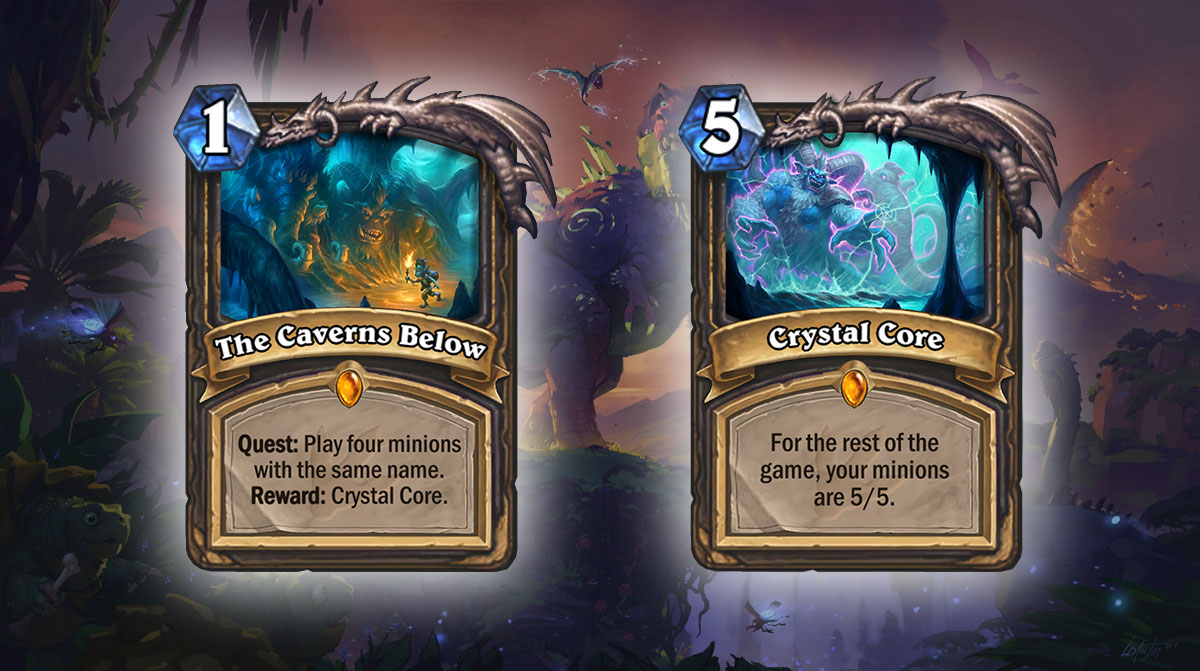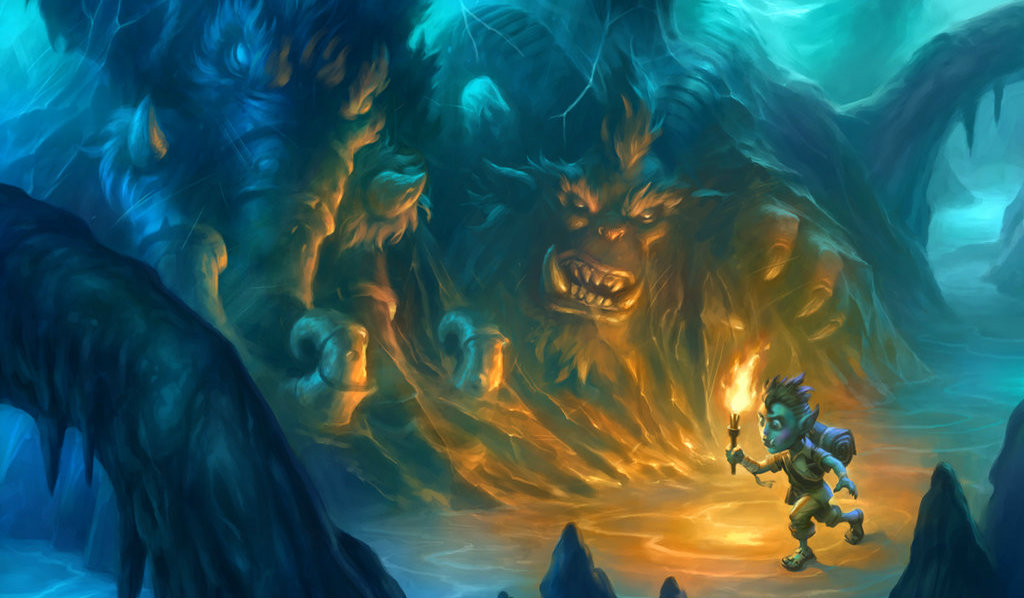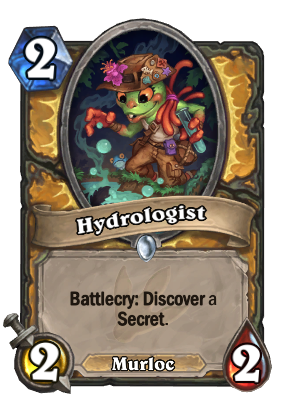Why Hearthstone players predicted the Rogue Quest wrong (and are still getting it wrong)
...and what that tells us about the psychology of evaluating the power level of new cards.

Without fail, every Hearthstone expansion features a card that is massively undervalued at first glance: Dr. Boom, Grim Patron, Mysterious Challenger, Reno, Finja and, this time, The Caverns Below. Pretty much everyone, from pros to casuals, agreed that the Rogue’s Quest was bad. In fact, from the data I saved from the Vicious Syndicate prediction poll on Reddit, The Caverns Below received the lowest rating of any quest: 3.2 out of 5 at the time I downloaded the data. 1 being “Terrible,” 3 being “Decent,” and 5 being “Meta Defining.” For perspective, the Warlock, Shaman, and even Druid quest had a rating of 3.5, Paladin had a 3.7, and the rest scored 4 or above, topping out with Hunter at 4.5 out of 5, which was tied for the highest average rating received of any card in the set. Talk about optimism.
In my evaluation of the card, I got Caverns a bit wrong too. While I didn’t put it in the ‘bad’ category of quests (opting for the ‘interesting’ instead), I did say it was “probably not good,” and that, “there are probably better Rogue strategies to use.” I’m still on the fence about how good Quest Rogue is compared to Miracle or Tempo lists, but it’s clear that Caverns decks are solid. I was also right in saying that if you manage to stall long enough to get the Quest off, it will close out the game in a turn or two, and that it poses the greatest deckbuilding challenge of any of the Quests in the set. A huge number of Caverns decks are seeing play, and still being refined—I’m updating mine several times a day and getting progressively happier with it.

The Caverns Below is a 1-mana legendary Rogue spell that starts in your opening hand. As with the other Quests, it can be tossed back in the mulligan stage. To fulfill its condition, it requires you to play (not summon) four minions with the same name, after which it rewards you with Crystal Core: a 5-mana spell that sets the base stats off all the minions on your board, in your hand, and your deck to 5/5.
The effect is an indestructible aura, meaning even minions that get transformed (by a spell like Hex) will become a 5/5. To make this Quest work, Caverns decks rely on cards with ‘bounce’ effects (like Shadowstep and Youthful Brewmaster), plus cheap minions to use them on, then subsequently fill the board once the 5/5 effect is in place.
All of which poses two big questions when it comes to how we rate the power level of cards. First, why did so many people get the prediction wrong and, second, why are people now (in my opinion) overvaluing the card?
As to why people thought the card was bad, The Caverns Below reminds me a lot of Grim Patron in that it’s a definite ‘build-around’ card. It requires a deck full of cards that are individually very bad, but add up to more than the sum of their parts. This was the same reason people underestimated Grim Patron, with Firebat saying at the time: “You have to build your whole deck around it to make it work and at that point your deck sucks.”
In both examples, players fell back on mental shortcuts (called heuristics) when making evaluations. These shortcuts help people make good decisions quickly, rather than optimal ones slowly. Usually it is bad to play Stonetusk Boar. If you put that card in your deck, your win rate tends to go down because it’s not good enough to warrant a deck slot. As such, when people were brainstorming Caverns deck lists, they already had an accurate sense of how powerful cards like Stonetusk Boar and Youthful Brewmaster usually were, which they applied to the hypothetical lists.
In general, this is a good thing to do when building decks—relying on the best information you have at the time—but in some cases it misfires. In this instance, the ideas are right: when the Caverns deck doesn’t activate its Crystal Core reward, you’re just playing a deck full of bad cards. When it does activate the Quest, however, the power level of all those cards jumps dramatically.

A similar type of mistake was made when players looked at Hydrologist in this set (which was rated 2.9 in the vS poll). Many saw the card and said, “Since Paladin Secrets are bad, this card must be bad because it only gets you bad cards.” What those reviews overlooked was (a) Hydrologist offered more than just the Secret, coming with a body to fill the empty Paladin 2-drop slot, and (b) it was also very flexible. It’s not that Paladin Secrets are bad inherently, it’s that they aren’t worth a deck slot on their own. When you can tailor what Secret you get to the situation, and get a 2/2 body to go with it, for only 2 mana, the sum is again greater than its parts.
The biggest gaming news, reviews and hardware deals
Keep up to date with the most important stories and the best deals, as picked by the PC Gamer team.
In that respect, Hydrologist is a lot like Dark Peddler: it’s potentially a 2 and 3-drop for a class that needs to fill those gaps, plus benefits from built-in flexibility.
In addition to the heuristic issue, the other reason people misjudged Caverns was simple: no one had a sense for just how quickly and consistently the Quest could be completed and activated. The answer to that question is usually around turns four or six when the deck works (often closer to 6), which is better than most people seemed to envision in the theory-crafting stage.
That the card is good enough to be a contender brings me to our second question: Why are people overvaluing the card now? There was an initial explosion of talk about how the card was overpowered and should be nerfed not five days into the new expansion. People swung on the quest from, “it’s a bad card,” to, “nerf this” in a matter of hours.
First, it is worth noting that I don’t think the Caverns decks are overpowered, at least not in their current incarnations. I’ve played a lot with the deck and against it, so I can tell you that it tends to get bullied hard by aggressive strategies like Pirate Warrior and Zoo. Indeed, I climbed to legend with Zoo and Cavern decks were one of my best matchups. The games weren’t even close for the most part. As the Rogue, I’ve completed a quest on turn four against Pirate Warrior and then died on turn five. That’s a fairly-common occurrence in the life of a Caverns Rogue player.
Losing to a Caverns blowout can give you a skewed perspective about the deck’s power level.
As a rule of thumb for assessing the power of decks, I couldn’t put it better than this from Reddit: “Before you make threads that a deck is overpowered, play 20 games with that deck.” Just as it’s hard to understand the true power level of a deck before the cards are released, you often don’t appreciate its weaknesses until you play it enough yourself. When you’re playing against a Caverns deck, they might get the nuts draw and seal the game on turn four before you can do anything. That’s certainly a memorable moment, but what you don’t see are all the other game’s in which the Rogue draws dead or gets overrun. The point is that losing to a Caverns blowout can give you a skewed perspective about the deck’s power level. You need the experience of both playing against the deck and with it to appreciate the actual power.
For what it’s worth, I think it’s a good deck with definite counters, but it may not be the best Rogue strategy as it comes with an inherent inconsistency given that your cards are not very good on their own. Part of the reason people are still misjudging the deck’s power level is because when the Core is successfully activated, the deck subsequently does things that feel very unfair. Whereas a 1/1 Stonetusk Boar is laughable, a 5/5 Stonetusk Boar is absurdly imbalanced. Patches is already overpowered, so pulling a 5/5 Patches from your deck while also developing a second 5/5 charger for 1 mana is a bad experience for many opponents.
Again, in this respect, the deck plays out a lot like Patron: it either sputters and dies or it creates an insurmountable board presence/insane burst damage quickly. This inevitably leads some people to complain that the deck isn’t very interactive or fun to play against: they either get the combo off and win or they don’t and lose (but let’s face it, CCG players complain about every single archetype).
Not to put too fine of a point on it, but that’s how combo decks need to work if they are to be viable. If the combo doesn’t let you do unfair things when it works, then there’s not much point in playing the combo, as the component pieces tend to otherwise be bad. Combo is a strategy that should have a place in Hearthstone, and it’s often one that rewards the best players with higher win rates if they can reach the skill ceiling.
The take-home messages here are simple: it’s easy to misjudge a card when it involves playing independently bad cards in your deck and it’s easy to misjudge a card that allows unfair things to happen when you don’t have experience on both sides of the match. While The Caverns Below has so far spawned some viable-to-strong decks, they are easily countered with aggressive (and cheap) strategies. When it comes to understanding the power of cards, predictions are not an exact science and people will always need time to adjust and adapt to the new meta. There will be room to talk about nerfs in time, but not during the first week of an expansion.

